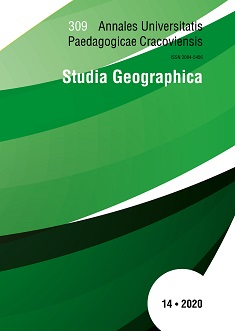Selected remnants of settlement related to the settlement of the Arctic on the example of Svalbard
DOI:
https://doi.org/10.24917/20845456.14.13Keywords:
Arctic, Svalbard, Spitsbergen Treaty, scientific stationsAbstract
In the paper there is presented a historical sketch of discovery of Svalbard and its consequences, which caused the beginning of settlement on this archipelago. The important aspect of the work is presentation of contemporary settlement web in the context of activity of whalers, trappers and mining companies. In the paper there are also shown consequences of introduction of Spitsbergen Treaty, influencing origination of settlement units. Presented material is a set of information possible to be used by the teachers implementing core curriculum, which enforce to the primary schools problems of northern and southern subpolar regions.
References
Amundsen, B. (1994). Svalbardboka. Oslo: Mitra.
Arlov, T.B. (1989). A short history of Svalbard. Oslo: Norsk Polarinstitutt Nr 4.
Birkenmajer, K. (1987). Lodospady szmaragdowe. Kraków: Wydawnictwo Literackie.
Catford, K.E. (2002). The industrial archaeology of Spitsbergen. Industrial Archaeology Review, 24/1.
Chochorowski, J. (1999). Problemy dendrochronologii rosyjskich stacji łowieckich na Spitsbergenie. Kraków: Uniwersytet Jagielloński – Instytut Archeologii.
Dolnicki, P. (2018.) Tradycje i zakres polskich badań polarnych na przykładzie działalności Polskiej Stacji Polarnej na Spitsbergenie. Studia Geographica, 12, 104–114.
Długosz, Z. (2001). Historia odkryć geograficznych i poznania Ziemi. Warszawa: PWN.
Encyklopedia Geograficzna Świata (1997). T. V. Europa. Kraków: Opres.
Gabzdyl, W. (1994). Geologia złóż węgla. Warszawa: Polska Agencja Ekologiczna.
Gawor, Ł., Dolnicki, P. (2005). Atrakcje geoturystyczne Spitsbergenu. Zeszyty Naukowe Politechniki Śląskiej, Górnictwo, 269, 179–188.
Gawor, Ł., Dolnicki, P. (2010). Zabytki techniki górniczej i obiekty dziedzictwa kulturowego Spitsbergenu (Svalbard, Arktyka). Przegląd Górniczy, 7–8, 74–77.
Gawor Ł., Dolnicki P. (2011). Abandoned mining sites as geotourist attractions of Isfjorden area (Svalbard). In: Altbergbaukolloquium 3. bis 5. November 2011, Meier G., Sroka A., Lobel K.H., Klapperich H., Tondera D., Busch W., Hardygóra M., Madziarz M., (eds.). Essen: VGE Verlag, s. 239–247.
Hagen, J., Liestøl, O., Roland E. (1993). Glacier Atlas of Svalbard and Jan mayen. Oslo: Torild Jørgensen.
Hisdal, V. (1998). Svalbard. Nature and history. Oslo: Norsk Polarinstitut Nr 12.
Jania, J. (1997). Glacjologia. Warszawa: PWN.
Krawczyk, A. (1987). Zagadnienia Normańskiego Svalbardu. XIV Sympozjum Polarne, Lublin 1987, s. 223–228.
Marsz, A., Styczyńska A. (2007). Klimat rejonu Polskiej Stacji Polarnej w Hornsundzie stan, zmiany i przyczyny. Gdynia: Wydawnictwo Akademii Morskiej.
Mityk, J. (1975). Geografia fizyczna części świata (zarys fizjograficzny). Warszawa: PWN.
Nowosielski, L. (2001). Spitsbergen – Svalbard (maszynopis). Hornsund.
Schmitt, E. (2001). Umweltwirkungen des Bergbaus auf Spitzbergen. Geographische Rundschau, 53, H. 9.
Starkow, S. (1987). Ruskoje articzeskojemorjepławnije i pochody na Szpicbjergen. Materiały XIV Sympozjum Polarnego. Lublin.
Store Norske Spitsbergen Kulkompanie. Coal mining – the basis for Norwegian presence. Longyearbyen, 2000.
Downloads
Published
Issue
Section
License
The submission of a paper to be published is synonymous with an agreement to transfer the copyright free of charge from the author to the publisher. The author also agrees to permit the publisher to publish the paper in printed form, open access online form, digital library form and other digital platforms with which the publisher has or will have a publishing agreement. Furthermore, the author agrees to not limit the number of copies that may be printed or issued by the publisher. In the case of co-authored papers, it is assumed that the corresponding author is authorized to represent the remaining co-authors in this respect. Authors are requested to sign a copyright declaration.

